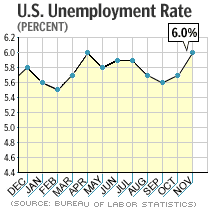NEW YORK (CNN/Money) -
The U.S. unemployment rate jumped back to its highest level of the most recent recession and businesses slashed thousands of jobs from payrolls in November, the government said Friday.
The report was overshadowed by theresignation of two members of President Bush's economic team.
The Labor Department said unemployment rose to 6.0 percent in November from 5.7 percent in October. Employers cut 40,000 jobs from non-farm payrolls after adding a revised 6,000 in October.

It was the highest unemployment rate since April; before that, the last time unemployment was so high was in August 1994. Economists, on average, expected unemployment of 5.8 percent and employers to add 35,000 jobs, according to Briefing.com.
"The jobless recovery remains with us, and the job machine is stuck in neutral at this point," Jared Bernstein, labor economist at the Economic Policy Institute, told CNNfn's CNNmoney Morning program.
U.S. stock prices fell after the report, while Treasury bond prices rose. Meanwhile, two members of President Bush's embattled economic team, Treasury Secretary Paul O'Neill and key economic advisor Lawrence Lindsey, submitted their resignations.
The sectors with the biggest job cuts were manufacturing, which cut 45,000 jobs, and retail, which cut 39,000 jobs. Job growth was found in services, which added 50,000 jobs, and the government sector, which added 8,000.
Economists were expecting the unemployment report to paint a much rosier picture, in part because weekly new claims for unemployment benefits had been steadily falling in recent weeks.
| 
| |

| 
| 
|

|
 Tim O'Brien reports on November unemployment rate rising to 6 percent, up from 5.7 percent. Tim O'Brien reports on November unemployment rate rising to 6 percent, up from 5.7 percent.
|
|
Play video
(QuickTime, Real or Windows Media)
|
| 
|

|
|
On Thursday, the number of people signing up for new unemployment benefits dropped to 355,000 during the week of Thanksgiving, the lowest number in 21 months, and the number of people drawing benefits for a week or more fell.
But pessimistic economists pointed out that the Thanksgiving week was only three days long and subject to seasonal adjustments that skewed the real picture of the labor market's health. And there's still a large number of people who have been unemployed so long that their benefits have expired.
"Many economists will end up eating humble pie this weekend because, while the relationship between the weekly initial unemployment claims and non-farm payrolls is fairly robust, we should also realize that it is not always a stable relationship from month to month," said Anthony Chan, chief economist at Banc One Investment Advisors.
The report could inspire the Federal Reserve to shift its policy stance from neutrality to concern about economic weakness when it meets Tuesday to discuss policy.
It also could lead to louder cries for President Bush or Congress to provide some economic stimulus in the form of tax cuts or spending and may have led to the resignations of O'Neill and Lindsey, who have been criticized by Democrats and some on Wall Street for not doing enough to stimulate the economy.
"The private sector's just not generating enough jobs here, and I would love to see some of the policy-makers in [Washington] wake up and take notice," Bernstein of the Economic Policy Institute said.
Rep. Jim Saxton, R-N.J., chairman of the joint economic committee of Congress, told CNNmoney Morning that making last year's tax cut permanent would go a long way to boosting the confidence of businesses and consumers.
"We have uncertainty resulting from international events -- the Iraq situation, as well as international terror -- while domestically, in Congress, we have done our part to create uncertainty with regard to spending policy, as well as tax policy," Saxton said. "We passed some tax cuts that are going to expire, and that creates uncertainty when people plan for their future."
While Democrats would disagree that a permanent tax cut is the best solution for the economy's problems, it seems unlikely that businesses will be inspired to hire again any time soon without some kind of intervention.
Slow economic growth in the fourth quarter, the geopolitical uncertainties mentioned by Rep. Saxton, a lack of corporate pricing power and other woes seem likely to postpone a significant pick-up in hiring until at least the second half of 2003, many economists think.
Non-farm payrolls need to grow by at least 125,000 jobs per month, most economists believe, in order to keep up with the natural growth of the labor force. If there's not enough job growth, the unemployment rate will continue to rise.
In Friday's report, the length of the average work week was stagnant for the second straight month, holding at 34.2 hours.
If there was any bright spot in the report, it was in another month of wage growth; the average hourly wage rose 4 cents to $14.93.
Steady wage growth, however anemic it has been at times, is one of the few things that has supported consumer spending through a recession that began in March 2001. Consumer spending is critical, since it makes up more than two-thirds of the total economy.
And Friday's bad news could put a crimp in what was already a shaky holiday shopping season.
"The jump in the unemployment rate will be a headline catcher ... telling consumers that perhaps the economy is weakening, which in turn could breed caution during this very critical holiday season," John Lonski, chief economist at Moody's Investors Service, told Reuters.

|

